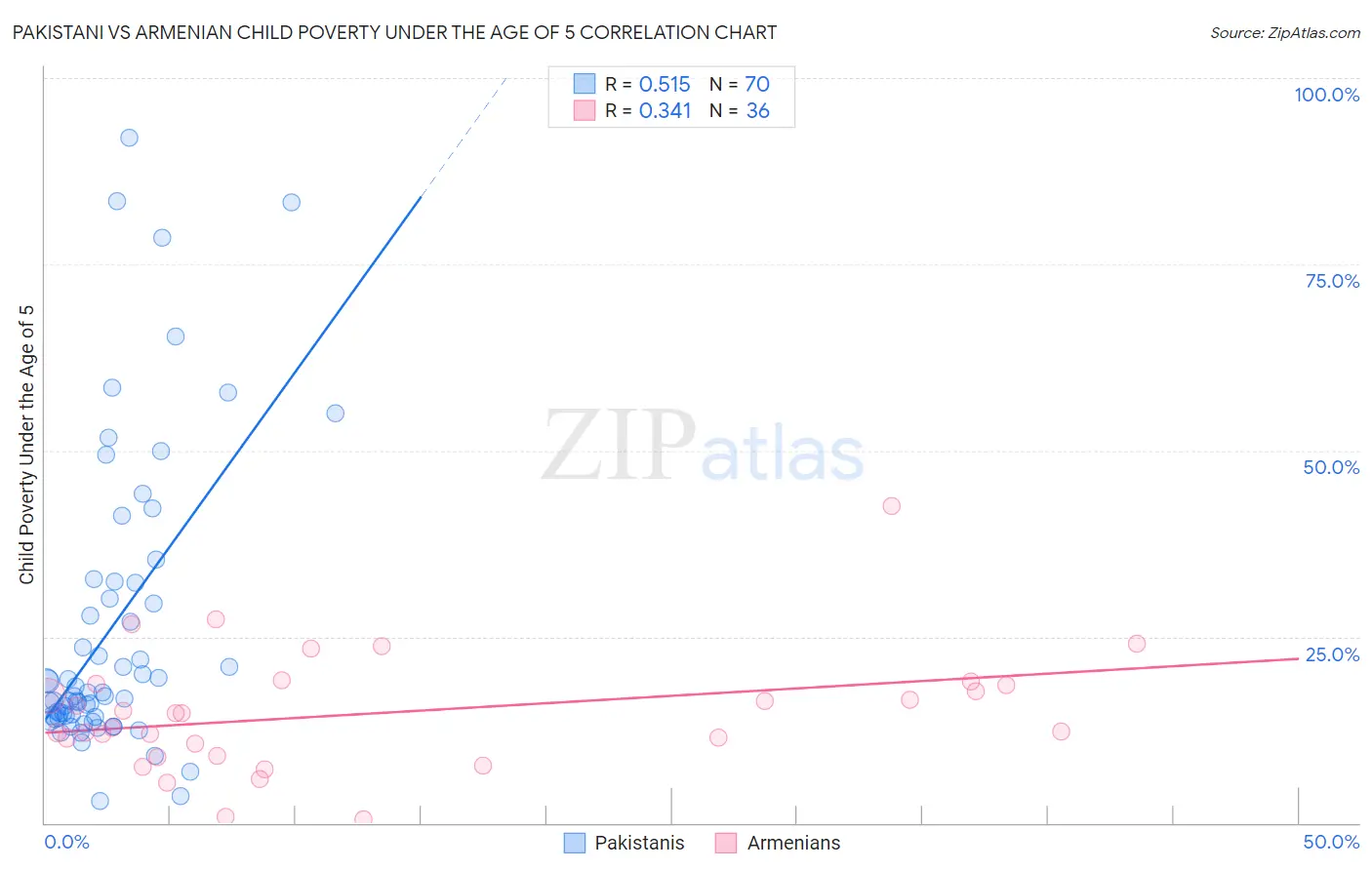Pakistani vs Armenian Child Poverty Under the Age of 5
COMPARE
Pakistani
Armenian
Child Poverty Under the Age of 5
Child Poverty Under the Age of 5 Comparison
Pakistanis
Armenians
16.0%
CHILD POVERTY UNDER THE AGE OF 5
94.2/ 100
METRIC RATING
111th/ 347
METRIC RANK
15.8%
CHILD POVERTY UNDER THE AGE OF 5
95.7/ 100
METRIC RATING
102nd/ 347
METRIC RANK
Pakistani vs Armenian Child Poverty Under the Age of 5 Correlation Chart
The statistical analysis conducted on geographies consisting of 324,820,623 people shows a substantial positive correlation between the proportion of Pakistanis and poverty level among children under the age of 5 in the United States with a correlation coefficient (R) of 0.515 and weighted average of 16.0%. Similarly, the statistical analysis conducted on geographies consisting of 297,364,427 people shows a mild positive correlation between the proportion of Armenians and poverty level among children under the age of 5 in the United States with a correlation coefficient (R) of 0.341 and weighted average of 15.8%, a difference of 0.90%.

Child Poverty Under the Age of 5 Correlation Summary
| Measurement | Pakistani | Armenian |
| Minimum | 3.0% | 0.42% |
| Maximum | 92.0% | 42.6% |
| Range | 89.0% | 42.2% |
| Mean | 26.2% | 14.7% |
| Median | 17.3% | 13.7% |
| Interquartile 25% (IQ1) | 14.3% | 9.8% |
| Interquartile 75% (IQ3) | 32.3% | 18.6% |
| Interquartile Range (IQR) | 18.0% | 8.8% |
| Standard Deviation (Sample) | 19.9% | 8.1% |
| Standard Deviation (Population) | 19.8% | 7.9% |
Demographics Similar to Pakistanis and Armenians by Child Poverty Under the Age of 5
In terms of child poverty under the age of 5, the demographic groups most similar to Pakistanis are Northern European (16.0%, a difference of 0.040%), Romanian (16.0%, a difference of 0.040%), Peruvian (16.0%, a difference of 0.050%), Puget Sound Salish (16.0%, a difference of 0.060%), and Immigrants from Brazil (16.0%, a difference of 0.12%). Similarly, the demographic groups most similar to Armenians are Immigrants from Zimbabwe (15.8%, a difference of 0.13%), Immigrants from Canada (15.8%, a difference of 0.14%), Palestinian (15.8%, a difference of 0.15%), Immigrants from South Africa (15.8%, a difference of 0.26%), and European (15.9%, a difference of 0.28%).
| Demographics | Rating | Rank | Child Poverty Under the Age of 5 |
| Immigrants | Kazakhstan | 96.2 /100 | #96 | Exceptional 15.8% |
| Macedonians | 96.2 /100 | #97 | Exceptional 15.8% |
| Immigrants | South Africa | 96.1 /100 | #98 | Exceptional 15.8% |
| Palestinians | 95.9 /100 | #99 | Exceptional 15.8% |
| Immigrants | Canada | 95.9 /100 | #100 | Exceptional 15.8% |
| Immigrants | Zimbabwe | 95.9 /100 | #101 | Exceptional 15.8% |
| Armenians | 95.7 /100 | #102 | Exceptional 15.8% |
| Europeans | 95.3 /100 | #103 | Exceptional 15.9% |
| Immigrants | North America | 94.9 /100 | #104 | Exceptional 15.9% |
| Immigrants | Spain | 94.8 /100 | #105 | Exceptional 15.9% |
| Tlingit-Haida | 94.7 /100 | #106 | Exceptional 15.9% |
| Slovenes | 94.4 /100 | #107 | Exceptional 16.0% |
| Immigrants | Brazil | 94.4 /100 | #108 | Exceptional 16.0% |
| Northern Europeans | 94.3 /100 | #109 | Exceptional 16.0% |
| Romanians | 94.3 /100 | #110 | Exceptional 16.0% |
| Pakistanis | 94.2 /100 | #111 | Exceptional 16.0% |
| Peruvians | 94.1 /100 | #112 | Exceptional 16.0% |
| Puget Sound Salish | 94.1 /100 | #113 | Exceptional 16.0% |
| Immigrants | Kuwait | 93.9 /100 | #114 | Exceptional 16.0% |
| Albanians | 93.8 /100 | #115 | Exceptional 16.0% |
| Immigrants | Austria | 93.5 /100 | #116 | Exceptional 16.0% |